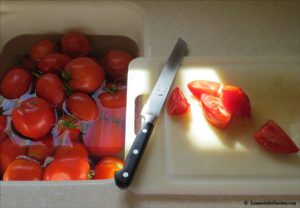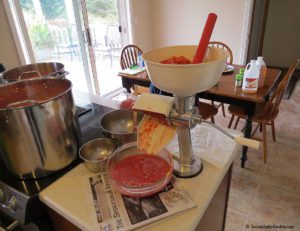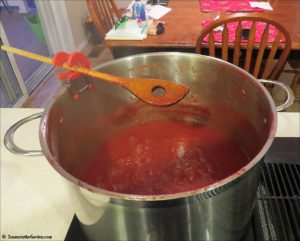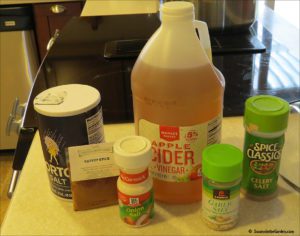How to Make Catsup

I know what you’re thinking. Why would anyone want to know how to make catsup. After all, you can just buy a bottle in the grocery store? I used to think that, too. That is, until we made our own just for fun many years ago. Homemade catsup is AMAZING! It’s kind of like a gourmet steak sauce in our opinion.
It all started when I was perusing the catalog from Nichols Garden Nursery, which is located in Albany, Oregon. I stumbled across the “Cook’s Corner” section where they were selling catsup spice. Intrigued, I ordered some. Little did I know it would become a tradition to make a batch of catsup every summer! (oh, and whether you spell it “catsup” or “ketchup,” this is tasty stuff, folks!)
It isn’t complicated but it is time-consuming. Why? You have to let the tomato puree boil down for a few hours until it’s the consistency of catsup. My best tip is to grow or purchase paste tomatoes such as ‘Amish Paste’, ‘San Marzano’, ‘Italian Pompeii’ or ‘Roma’. Paste tomatoes are different from regular tomatoes because they are much meatier and have less juice. That means they’ll boil down much more quickly which is the goal.
Let’s go through the steps:
Wash the tomatoes and cut them into large chunks. They don’t need to be peeled ahead of time.
Use a food strainer (such as a Roma or Squeezo) to turn the chunks into puree. These types of mills use screens that separate the skins and seeds of the tomatoes from the meaty pulp. They work great. We actually own both types of strainers. I’m much happier with the Roma strainer, which is great because it’s less expensive. Food strainers also work well for making applesauce, by the way. Remember that you can click on any of the photos to view a larger image.
The recipe on Nichols’ catsup spice calls for two gallons of tomato puree. You can certainly adjust the recipe accordingly. Here’s the time-consuming part, depending on how watery your tomatoes are. Place a kettle of the puree on the stove on a medium-high heat and let it slowly boil down. Be sure to stir it occasionally so it won’t burn on the bottom of the pan. This process can take anywhere from 2 to 12 hours; ours took about 5 hours because some of the tomatoes we used were a little on the juicy side.
Here’s a tip to speed things up a bit: after about 3 hours of boiling, we used a large sieve to separate the tomato “solids” in the puree from the watery juice. All you do is scoop a bunch of the puree and hold it over a large container (let’s call it container #2) to let the thin juice strain into it. That leaves your sieve filled with the tomato solids; pour those solids into a third kettle. This is what you’ll be making the catsup with. The thin juice that you end up with in container #2 makes a terrific soup stock that you can freeze in containers or freezer bags for later use. Zero waste!
Once your boiled puree (or the strained solids, if you used the above tip) is the consistency of catsup, add your spices and other ingredients. We used the ingredients shown in this photo, which are part of the recipe listed on the catsup spice packet. (If you would like to use a basic catsup recipe instead, here’s one from Ball Canning.) Once you add in your spices, sugar, vinegar, etc., let it continue to cook for about 30 minutes.
In the meantime, wash and sterilize canning jars that use two-piece canning lids. We use pint-size jars. Also bring a water-bath canner to boil. Fill the jars with your lovely catsup, leaving 1/2-inch head space. Wipe the rims of the jars with a damp paper towel, then screw on the lids tightly. Boil them in a water-bath canner for 10 minutes (add additional time if you live in a higher altitude like we do). Carefully remove the jars from the canner and let them cool down in a draft-free area. Make sure the lids have sealed* before you move them to a cool, dark storage area (* never push down on the lids to see if they’ve sealed. Let them seal on their own; if they don’t, they will need re-processing and possibly new lids)
OK, that was a bit of work, wasn’t it? But once you taste your homemade catsup, you will be sold on doing this, believe me! We dole out our catsup through the course of the year so we won’t run out before the following year’s tomato-canning season. I hope you’ll consider trying this!




